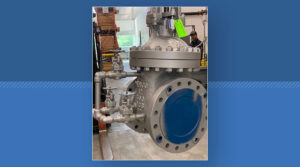
RPTFE Seat – Applications in Industry, vs. PTFE
RPTFE stands for Reinforced Polytetrafluoroethylene and provides a common valve seat coating material. This is largely because it has several desirable attributes that ensure the long-term integrity of the seat. In this article, we review RPTFE seat use, its temperature range, and compare RPTFE vs PTFE.
RPTFE Seat Application
Although PTFE can be reinforced using filler materials such as carbon and stainless steel (316), RPTFE refers to when fiberglass is used. Producing RPTFE adds between 15% and 25% fibrous glass to virgin Teflon thereby improving the design life of the valve seat. As a result of the glass reinforcement, its features and applications include:
- Greater pressure and temperature rating.
- Improvement of mechanical strength and resistance to abrasive wear.
- Fire resistant.
- Also, the valve seat becomes less prone to creep/cold flow as well as permeation in molded seats.
- RPTFE provides an ideal material for throttle valves in the food, dairy, and pharmaceutical industry.
However, RPTFE should not be used in applications where the working fluid contains elements that attack glass. Some of these include hydrofluoric acid and strong caustics.

RPTFE Valve Applications
Due to its desirable properties, RPTFE is used in manufacturing several valve parts such as gaskets, housings, bearings, etc. Depending on the needs of the application and the valve part, the fiberglass content would vary between 5% and 40%. Another reason for its broad application is that it combines with a variety of base metals including steel, aluminum, and brass. This makes it an ideal choice for making valve seats, which usually undergo significant frictional, thermal, and impact stress.
Manufacturing Valve Seats
Generally, the manufacturing of valve seats follows either a casting or powder metallurgy method.
- Casting: Initially, valve seats were produced by melting and mixing different metals together to form a cast alloy. After putting the molten material in a mold, adjusting the cooling rate influences the physical properties of the end product. Also, heat treatment serves to further alter features such as microstructure, strength, and hardness.
- Powder Metallurgy: Powder metal seats have become the predominant option in valve manufacturing because it allows the mixing of precise amounts of dry metal powders. After achieving the right mix, the powder metals undergo intense pressure to become a solid composite with consistent properties. This process enables manufacturers to provide seats with more specific features to suit an application. Other advantages include precise control on tolerances, smoother finish which reduces machining needs, and better structural integrity.
After forming the base metal, the RPTFE coating is applied to complete the seat. But, before applying the coating, the combination of the fiberglass and PTFE is usually by inert gas sintering. This helps reduce porosity and improve creep properties.
Other PTFE Fillers
Apart from fiberglass, there are other filler materials that are useful when reinforcing valve seats. Some common fillers include:
- Carbon-filled PTFE: Similar to glass, carbon graphite enables PTFE seats to withstand high temperatures and pressures. Also, it provides better wear characteristics and thermal cycling resistance while delivering a low friction coefficient. Carbon-filled PTFE seats provide tight shut-off capabilities when isolating steam (up to 10 barg), condensate, or hot water lines, as long as there are no material compatibility issues. In addition, it is inert to most media.
- Steel-reinforced PTFE: This usually constitutes 50% powdered 316 stainless steel and 50% PTFE. Due to the presence of steel, it offers a wider operating range for both temperature and pressure. However, the higher friction coefficient than its glass and carbon reinforcements leads to faster wear and high stem torque.
- Bronze-filled PTFE: Usually provided in up to a 60% ration, the presence of bronze increases the seat compression strength, abrasion resistance, and provides high thermal conductivity. However, it reduces chemical resistance.
- Molybdenum Disulphide-filled PTFE: This compound makes an excellent choice when there is a need to increase valve seat hardness and wear resistance. It also reduces friction.
RPTFE Temperature Range
One of the benefits of the presence of fiberglass in RPTFE is the increase in temperature rating of the material. The level of this increase is dependent on the percentage of glass fill in the seat, which is usually between 15% and 25%. RPTFE has a decent temperature range in comparison to other materials as the table below shows.
| Valve Seat Material | Temperature Range | Color |
| PTFE | -50℉ to 400℉ | White |
| RPTFE | -50℉ to 450℉ | Off-white |
| Carbon-filled PTFE | -50℉ to 450℉ | Black |
| Stainless steel reinforced PTFE | -20℉ to 550℉ | Grey |
| Bronze-filled PTFE | -400℉ to 400℉ | Dark brown |
RPTFE vs PTFE
Although they have the same base material, RPTFE offers significant improvers over PTFE (virgin Teflon). The following table highlights the differences between the two materials when used for valve seats.
| Feature | RPTFE | PTFE |
| Composition | Teflon plus 15% to 25% fiberglass. | Virgin Teflon. |
| Temperature Range | -50℉ to 450℉ | -50℉ to 400℉ |
| Maximum Pressure | 2,000psi | 1,000psi |
| Color | Off-white | White |
| Chemical Compatibility | Sensitive to chemicals that attack glass. | Excellent compatibility for most applications. |
| Design Life | More robust so typically lasts longer. | Not as robust as RPTFE |
| Friction | Increase in flow friction due to the presence of glass fibers. | Lower friction coefficient. |
| Abrasion Resistance | Better abrasion resistance because of reinforcement. | Would wear faster than RPTFE. |


